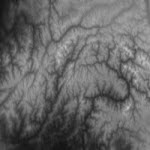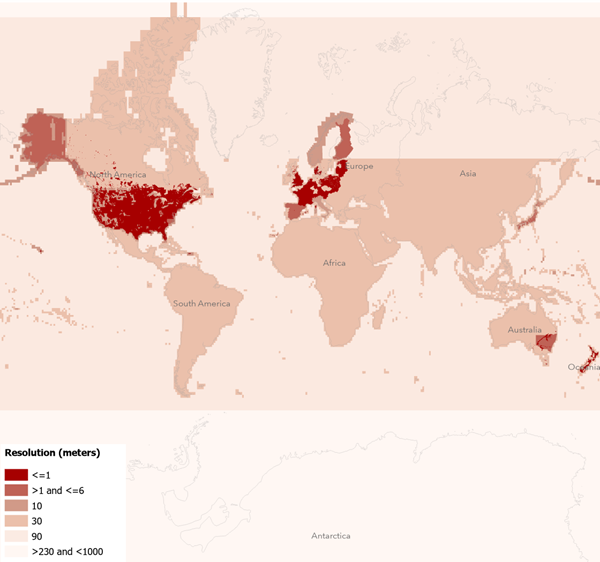
The Terrain multiresolution layer provides access to elevation values for use in analysis with functions for slope, aspect, and hillshade.
Service Name: Terrain
Note:
The Terrain service is not included with Collection 1.
Description
This dynamic image service provides numeric values representing ground surface heights based on a digital terrain model (DTM). The ground heights are based on multiple sources. Heights are orthometric (sea level = 0), and water bodies that are above sea level have approximated nominal water heights.
This layer is generally not optimal for direct visualization. By default, 32-bit floating point values are returned, resulting in higher bandwidth requirements. Therefore, usage should be limited to applications that require elevation data values. Alternatively, client applications can select from numerous additional functions, applied on the server, that return rendered data. For visualizations such as hillshade, elevation tinted hillshade, and slope, consider using the appropriate server-side function defined on this service.
Server functions
This layer has server functions defined for the following elevation derivatives:
- Slope Degrees
- Slope Percentage
- Aspect
- Ellipsoidal Height
- Hillshade
- Multi-Directional Hillshade
- Elevation Tinted Hillshade
- Slope Map
- Aspect Map
Data sources
The data for this layer comes from the multiple sources and data extents of each source and can be explored using \\<server-ip>\CollectionX_source_documents\data\WorldElevation\DataExtentsMap in which <server-ip> is the network IP or server name of the data appliance, and CollectionX is the collection where the World Elevation content is located: Collection2 (World Standard), Collection3 (World Advanced), Collection4 (North America Standard), or Collection5 (North America Advanced).
For more information, see Use the Terrain service.
Mosaic method
This image service uses a default mosaic method of By Attribute, using Field Best and target of 0. Each of the rasters has been attributed with a Best field value that is generally a function of the pixel size such that higher-resolution datasets are displayed at higher priority. Other mosaic methods can be set, but care should be taken because the order of the rasters may change. Where required, queries can also be set to display only specific datasets, such as only National Elevation Dataset (NED), or the lock raster mosaic rule used to lock to a specific dataset.
Accuracy
The accuracy of these services will vary as a function of location and data source. Refer to the metadata available in the services, and follow the links to the original sources for further details. Estimates of CE90 and LE90 are included as attributes.
Attribution
Sources: USGS, NGA, NASA, CGIAR, NLS, OS, NMA, Geodatastyrelsen, GSA, GSI and the GIS User Community
Coverage
The following coverage map illustrates the coverage of the layer:
